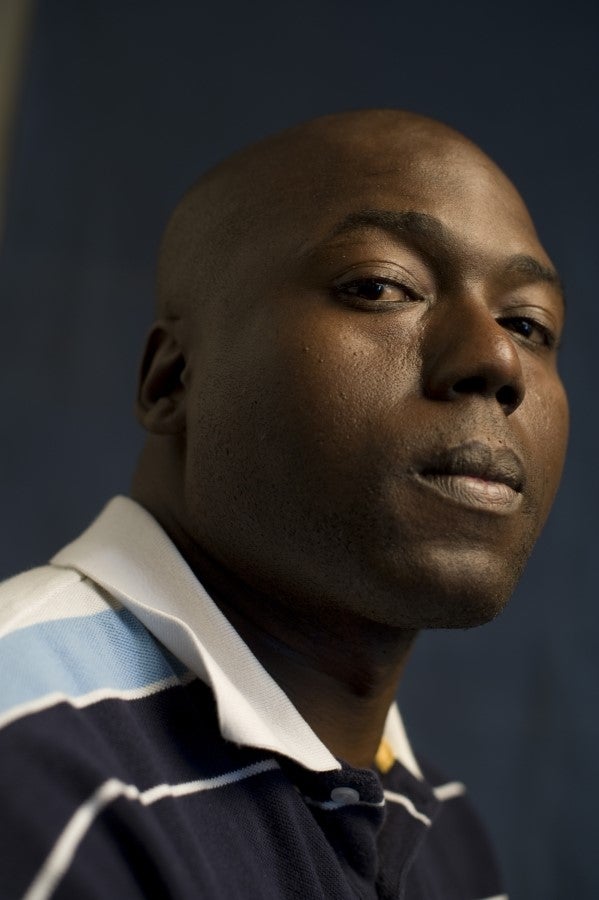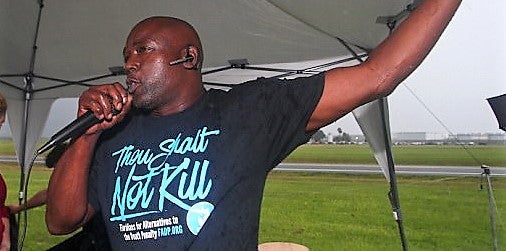‘I was about to die for something I didn’t do’: Meet the numerous people on death row who are innocent
How corrupt policing, racial bias, and federal law sends innocent people to death row at alarming rates, Josh Marcus writes


Your support helps us to tell the story
From reproductive rights to climate change to Big Tech, The Independent is on the ground when the story is developing. Whether it's investigating the financials of Elon Musk's pro-Trump PAC or producing our latest documentary, 'The A Word', which shines a light on the American women fighting for reproductive rights, we know how important it is to parse out the facts from the messaging.
At such a critical moment in US history, we need reporters on the ground. Your donation allows us to keep sending journalists to speak to both sides of the story.
The Independent is trusted by Americans across the entire political spectrum. And unlike many other quality news outlets, we choose not to lock Americans out of our reporting and analysis with paywalls. We believe quality journalism should be available to everyone, paid for by those who can afford it.
Your support makes all the difference.Herman Lindsey used to lie awake at night in his cramped jail cell in Florida, fantasizing he was a cowboy or a detective from the stories he read to pass the time until his execution date. His anxiety was so severe that even medication couldn’t get him to sleep. The only thing that seemed to work was imagining that he was living a different life instead of his own.
In 2006, he was sent to death row for a murder-robbery he didn’t commit. Investigators believed they had cracked a 12-year cold case, even though they had no evidence tying Mr Lindsey to the scene of the crime. Once he was on the inside, Herman withdrew into pain and depression, declining to see his family, watching his fellow inmates get executed. He began losing hope his appeals would ever work out, even though he knew he didn’t kill pawnshop owner Joanne Mazzola in 1994.
“It’s like you’re tied up and you’re about to die for something you didn’t do, and you have to sit there and wait, and you have to depend on the same people that actually put you there to get any kind of relief,” he told The Independent. “You don’t have too much confidence that this person that tied you up and is going to kill you is going to let you go. They’re not trying to let you go.”
Not that he had lived his life believing the odds were in his favour, especially in the criminal legal system. Growing up, he knew good cops and bad ones. Multiple friends were killed by police. Mr Lindsey came from a poor family and sold drugs to make ends meet, but he wasn’t a murderer. It didn’t seem to matter in court, however, who he really was, that he had started figuring things out, running his own car detailing business, with a son on the way. He felt the legal system was never going to trust someone coming from a background like his.
“I put myself in a bad place, which makes it easier for the police to get a conviction because society says, ‘You did this before. You’ve been arrested for this before. You’re a criminal and you can’t be trusted, and you won’t tell the truth,’” Mr Lindsey said. He was first arrested when he was 14. “Society believed that. It makes you an easy victim.”
In 2009, however, the Florida Supreme Court considered an appeal in his case, ruling unanimously that there wasn’t enough evidence to find him guilty of any crime, and that overzealous prosecutors had so inflamed the jury that he didn’t get a fair trial. He was only the 23rd man let off Florida death row in the state’s history. And believe it or not, despite spending years on death row as an innocent man, Mr Lindsey, who is now 48, was one of the lucky ones. Not everyone who is innocent gets out.
In the modern era of the death penalty, American has executed more than 1,500 people. But a staggering number of those on death row have done nothing wrong. Since the mid-1970s, about one wrongfully convicted person on death row has been exonerated for every 8.3 who are executed, according to a groundbreaking analysis from the Death Penalty Information Center (DPIC). To understand how that happens is to take a journey into one of the strangest and darkest corners of the justice system. On death row, sometimes even those who confess are innocent.
“The number of people who have given false confessions in these exoneration cases is a lot higher than most people would think,” according to legal expert Jeff Newberry of the University of Houston, who supervises the school’s Death Penalty Clinic and has represented numerous inmates bound for death row. “Most people say, ‘Well if he confessed then he must be guilty.’ It’s just a tremendous amount of pressure. I think the average person has no idea of how coercive these environments are.”
Capital suspects, almost always poor and often young men of colour, can be interrogated for hours by police without proper legal representation until they break. Former Chicago police commander John Burge and his officers allegedly tortured more than 100 suspects, including eventual capital defendants, until they were made to confess to whatever investigators wanted. (Burge was sentenced to four-and-a-half years in prison for lying under oath in suits related to the torture claims, and died in 2018 after being let out for good behaviour.)
Death penalty appeals often take decades, meaning that ongoing cases are the result of the worst retrograde policing and prosecutorial practices of the past.
During the penalty phase of Mr Lindsey’s trial in Florida, prosecutors were supposed to ask him holistic questions about his life circumstances and what led up to the alleged crime, before a jury decided on whether he deserved the death penalty. Instead, a government lawyer asked, ‘’Why did you put a gun to her head and pull the trigger?’’
A Florida Supreme Court Justice later wrote that the “prosecution’s comments were not only improper but were also prejudicial and made with the apparent goal of inflaming the jury.’’
Even in death row cases where someone else has out-and-out confessed to the underlying crime, people awaiting execution face Kafka-eqsue legal odysseys to secure their freedom. They become mired in a legal appeals process so confined to technical questions that the overall question of innocence can seem to fade away.
Tyrone Noling, who is currently on death row in Ohio, has been fighting for his freedom since being charged for a gruesome 1990 double-murder in rural Portage County. Lawyers from the Ohio Innocence Project (OIP) believe he has a compelling case.

Following the brutal shooting deaths of Bearnhardt and Cora Hartig, both 81, in the small village of Atawater Township, police struggled to find immediate suspects. “It’s a big scandal there wasn’t an immediate arrest,” said Brian Howe, a University of Cincinnati law professor who works with the OIP. “As the investigation drags on and on, there’s more and more pressure for law enforcement to come up with something.”
Eventually, after multiple attempts to charge Mr Noling failed, police returned Mr Noling and his associates in 1995, after the man had admitted to a series of robberies in a nearby town, using a gun of the same .25 caliber that killed the Hartigs. (Ballistics tests, however, showed that the two weapons weren’t a likely match.) Investigators called in a child psychologist who convinced the youngest member of Mr Noling’s circle, just 16-years-old, using hypnosis that he had memories of the crime that he had repressed. Police then offered the teen and three others deals to testify against Mr Noling.
One of these individuals recanted before the trial even began, and the others did later. Another man, Dan Wilson, who was executed in 2009 for burning a woman alive, allegedly confessed the killings to his foster brother, who reported the confession to police. Investigators ignored other key suspects, according to OIP. The jury that sent Mr Noling to his death was informed of none of this.
“Tyrone’s case is one that just sort of makes me want to just scream sometimes,” Mr Howe said. Mr Noling has been engaged in a tortuous appeals process since, marred by lost files, deeply wonky procedural denials, and most recently, the Ohio Supreme Court’s 2018 refusal to DNA test evidence from the scene. “It’s always a very dry, technical, piece of the story. At any given point, that’s usually what’s in front of the court,” Mr Howe continued, “I don’t understand how it’s possible that this person is still in prison, much less on death row.”
The adoption of DNA testing in the late 1980s opened the doors of death row just a crack to overturning wrongful convictions, but many cases don’t have DNA evidence. The world of capital cases is rarely as neat and tidy as an episode of CSI.
In place of such hard evidence, human factors like bias, class, politics, and geography often decide who goes to and dies on death row, rather than true guilt or innocence.
Black men, especially those allegedly involved in crimes with white victims, are vastly overrepresented on death row—and in those few who are exonerated. Eyewitness testimony, which has been shown over and over again to be unreliable, often forms the bedrock of capital cases.
Luck is just as much a factor. Though 27 states, largely in the US South, still have the death penalty on the books, the largest numbers of death sentences come from a small number of jurisdictions like Oklahoma County, home to Oklahoma City, and Harris County, Texas, home to Houston.
“Zip code really does matter a lot and that results in a very arbitrary system of justice,” said Kristin Houlé Cuellar, executive director of the Texas Coalition to Abolish the Death Penalty, a non-partisan advocacy group. “And then of course we know that the death penalty has always been racially biased and continues to be. Racial bias permeates the system from top to bottom.”
Structural barriers have played a role as well. The 1996 Antiterrorism and Effective Death Penalty Act limited the ability of death row inmates to make appeals in federal courts. Prosecutors are allowed to screen potential jurors to make sure they are, in the strange argot of capital punishment, “death-qualified”—that is, to serve in a capital case, jurors must not be fundamentally opposed to the death penalty. Public support for the death penalty has been declining for decades to near record lows, yet those more likely support the death penalty, who tend to skew white and conservative, end up most likely to be weighing the life and death of the people of colour most likely to be executed.

Despite these serious questions, the death penalty remains because of its political saliency in a certain number of conservative jurisdictions, according to Mr Newberry of the University of Houston.
“I don’t think the average person thinks about the death penalty at all,” he said. “The reason we still have it is that prosecutors feel the need to be ‘tough on crime.’ They think that if this is removed, if legislation takes away death as a sentencing option, if prosecutors are not going to seek death, they’re going to look weak.”
Change at the national level remains unlikely with a gridlocked Congress, though President Biden’s Justice Department instituted a moratorium on federal executions this summer. (Previously, after a 17-year pause, Donald Trump restarted federal executions, and 13 were killed during the second half of 2020, the most federal inmates put to death under one president in the last 120 years.) The president campaigned on opposing capital punishment, and has the power to commute all federal inmates’ sentences with the stroke of a pen, but so far hasn’t taken any concrete action beyond stopping the killings.
Still, despite these odds, anti-death penalty advocates have nonetheless made gains in recent years, as an increasingly bipartisan coalition of legislators, advocates, faith leaders, racial justice activists, and exonerees like Mr Lindsey have gotten capital punishment outlawed even in unlikely places like Virginia, which ended executions earlier this year, the first Southern state to take such a step.
And even if every one of the more than 2,500 people on state and federal death row were free, those who have survived a capital conviction will still be putting together the pieces of their life.
Mr Lindsey, who still lives Florida, and is a board member of the exoneree-led advocacy group Witness to Innocence, says he’s now serving a “public life sentence.” His name has been cleared, but he’s struggled to find work or obtain health insurance.
He still battles anxiety, and he never received compensation for the years he was mistakenly put behind bars.
What gives him hope, however, is that the pain he has experienced in his life has also made people take heed of his voice. He’s spent his time on the outside campaigning against the death penalty and mentoring youth. Something so simple as truly being heard becomes a great luxury when you’ve been wrongly imprisoned and sentenced to die.
“When I speak up, as someone who’s been on death row, it’s like I get full attention. I looked at how powerful I could be if I used myself as a tool to educate people,” he said.
The way he sees it, the criminal legal system has never wrongfully convicted anyone, including him: the process worked the way it was designed to, and individual people, knowing what they did, made the choice to send him to death.
But there’s a flip side to that understanding: human beings set up the system, and human beings make it work, so that means those same human beings can be convinced, after thousands are killed, to build a system that does something different.
This article was amended on 13 October, 2021. Its headline and body text both previously inaccurately stated that one in nine people on death row were later found to be innocent. The study referred to found that for every 8.3 people executed between 1972 and this year, one person had been exonerated. However, far more people are sentenced to death than are ever executed. Around 2 per cent of people on death row during that period have later been exonerated.
The Independent and the nonprofit Responsible Business Initiative for Justice (RBIJ) have launched a joint campaign calling for an end to death penalty in the US. The RBIJ has attracted more than 150 well-known signatories to their Business Leaders Declaration Against the Death Penalty - with The Independent as the latest on the list. We join high-profile executives like Ariana Huffington, Facebook’s Sheryl Sandberg, and Virgin Group founder Sir Richard Branson as part of this initiative and are making a pledge to highlight the injustices of the death penalty in our coverage.









Join our commenting forum
Join thought-provoking conversations, follow other Independent readers and see their replies
Comments